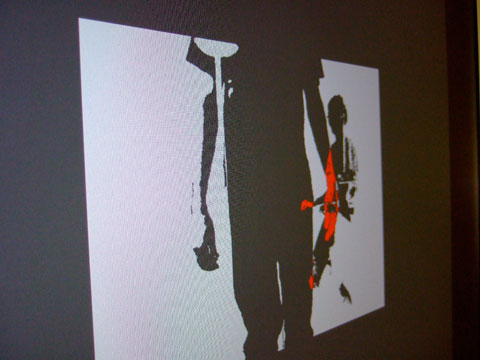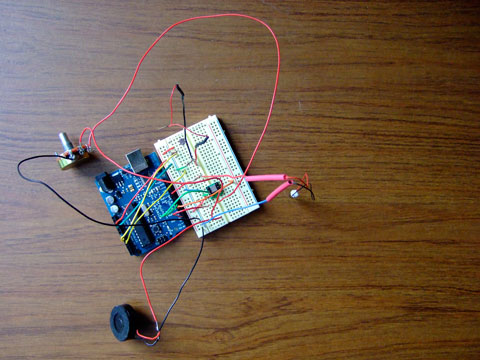

In this program, each bubble has a note (in C major) associated with it. When a silhouette in the video feed overlaps with the bubble, the note is sent to an audio program (Reason, in this case) in the form of a midi note. The bubbles can be moved left and right using an Arduino equipped with an accelerometer.
Similar to the above, but now two video feeds are incorporated. Now bubbles can only be played if they overlap with red sections of the video. Red sections are created when two silhouettes from separate video feeds overlap, so cooperation between people in the two video feeds is necessary to create notes.
Both these programs build on the programs from my previous two posts.

In this project, people in two separate rooms are videotaped. The two video feeds are fed through Processing, converted into silhouettes and superimposed over each other. Both rooms receive the same projection of the superimposed silhouettes. When silhouettes from the two rooms overlap, the overlapped area turns red and a midi note is sent to an external audio program (Reason, in this case).
The video feeds are initialized using a background subtraction technique, so only new objects in the space (ie: people) are fed back as silhouettes. The program sends midi notes using the RWMidi library. The program contains four different modes, some in which participants hear the same sounds, some in which they hear different sounds. All notes are currently in the C major scale.
My version sounds like this (all sounds can be modulated in the sound program you choose):
Audio clip: Adobe Flash Player (version 9 or above) is required to play this audio clip. Download the latest version here. You also need to have JavaScript enabled in your browser.


I hooked up an accelerometer, a light sensor, a piezo pressure sensor, a small speaker ripped out of a phone, a vibrating motor and a potentiometer to an Arduino. The tilt of the accelerometer controls the pitch of the speaker (with some random noise thrown in for effect), the light sensor controls the speed of the motor, the potentiometer controls the volume and the piezo can be squeezed to make a high-pitched tone in the speaker. All variables from the sensors are printed to the serial port.